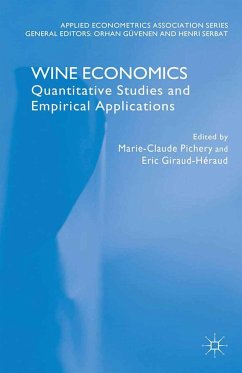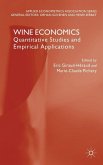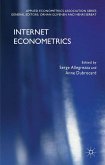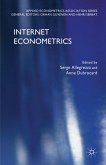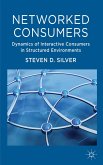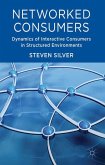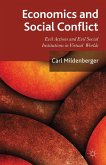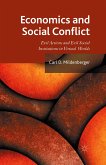Wine Economics
Quantitative Studies and Empirical Applications
Herausgegeben:Güvenen, O.; Serbat, H.; Giraud-Héraud, E.; Pichery, M.
Wine Economics
Quantitative Studies and Empirical Applications
Herausgegeben:Güvenen, O.; Serbat, H.; Giraud-Héraud, E.; Pichery, M.
- Broschiertes Buch
- Merkliste
- Auf die Merkliste
- Bewerten Bewerten
- Teilen
- Produkt teilen
- Produkterinnerung
- Produkterinnerung
The book proposes an overview of the research conducted to date in the field of wine economics. All of these contributions have in common the use of econometric techniques and mathematical formalization to describe the new challenges of this economic sector.
Andere Kunden interessierten sich auch für
![Wine Economics Wine Economics]() Wine Economics75,99 €
Wine Economics75,99 €![Internet Econometrics Internet Econometrics]() Internet Econometrics38,99 €
Internet Econometrics38,99 €![Internet Econometrics Internet Econometrics]() Internet Econometrics38,99 €
Internet Econometrics38,99 €![Networked Consumers Networked Consumers]() Steven SilverNetworked Consumers38,99 €
Steven SilverNetworked Consumers38,99 €![Networked Consumers Networked Consumers]() Steven SilverNetworked Consumers38,99 €
Steven SilverNetworked Consumers38,99 €![Economics and Social Conflict Economics and Social Conflict]() C. MildenbergerEconomics and Social Conflict75,99 €
C. MildenbergerEconomics and Social Conflict75,99 €![Economics and Social Conflict Economics and Social Conflict]() C. MildenbergerEconomics and Social Conflict75,99 €
C. MildenbergerEconomics and Social Conflict75,99 €-
-
-
The book proposes an overview of the research conducted to date in the field of wine economics. All of these contributions have in common the use of econometric techniques and mathematical formalization to describe the new challenges of this economic sector.
Produktdetails
- Produktdetails
- Applied Econometrics Association Series
- Verlag: Palgrave Macmillan / Palgrave Macmillan UK / Springer Palgrave Macmillan
- Artikelnr. des Verlages: 978-1-349-45018-3
- 1st ed. 2013
- Seitenzahl: 374
- Erscheinungstermin: 1. Januar 2013
- Englisch
- Abmessung: 216mm x 140mm x 21mm
- Gewicht: 491g
- ISBN-13: 9781349450183
- ISBN-10: 1349450189
- Artikelnr.: 45070138
- Herstellerkennzeichnung
- Libri GmbH
- Europaallee 1
- 36244 Bad Hersfeld
- gpsr@libri.de
- Applied Econometrics Association Series
- Verlag: Palgrave Macmillan / Palgrave Macmillan UK / Springer Palgrave Macmillan
- Artikelnr. des Verlages: 978-1-349-45018-3
- 1st ed. 2013
- Seitenzahl: 374
- Erscheinungstermin: 1. Januar 2013
- Englisch
- Abmessung: 216mm x 140mm x 21mm
- Gewicht: 491g
- ISBN-13: 9781349450183
- ISBN-10: 1349450189
- Artikelnr.: 45070138
- Herstellerkennzeichnung
- Libri GmbH
- Europaallee 1
- 36244 Bad Hersfeld
- gpsr@libri.de
Eric Giraud-Héraud is Research Director at the French National Institute for Agricultural Research (INRA), and Professeur Associé at the Ecole Polytechnique (Paris, France). His research focuses on industrial organisation and experimental economics. His works deals with the economics of food (economic efficiency, competitiveness, public regulation of supply, quality labels and consumer behaviour). He was the President of the European Association of Wine Economists (2003-2006) and currently one of the members of the Scientific Council of the Institut des Sciences de la Vigne et du Vin (ISVV) at Bordeaux. He is a member of the EuAWE (European Association of Wine Economists) and the VDQS (Vineyard Data Quantification Society). Marie-Claude Pichery is Professor of Economics and Econometrics at University of Bourgogne (Dijon, France) and a researcher at the Laboratoire d'Economie et Gestion (CNRS). She gives lectures in Wine Economics at the Institut Universitaire de la Vigne et du Vin - Jules Guyot (IUVV). Her fields of research are in wine industry and territorial aspects of vineyards. She has been President of the European Association of Wine Economists (1997-1999) and is currently a member of the scientific advisory council of the Chaire UNESCO 'Culture et Traditions du vin' hosted by University of Bourgogne. She is a member of the EuAWE (European Association of Wine Economists) and the VDQS (Vineyard Data Quantification Society).
PART I: ALCOHOL CONSUMPTION AND WELFARE 1. Life Satisfaction and Alcohol Consumption: an Empirical Analysis of Self-Reported Life Satisfaction and Alcohol Consumption in OECD countries; Jan Bentzen and Valdemar Smith 1.1. Introduction 1.2. Literature Review and Issues in the Happiness-income 1.3. Modelling of the Happiness-alcohol Relationship 1.4. Alcohol Consumption and Life Satisfaction 1.5. Estimating the Happiness-alcohol Model 1.6. Conclusions 2. Advertising and the Demand for (non)Alcoholic Beverages; Ruben Hoffman and Yves Surry 2.1. Introduction 2.2. The Alcohol Market 2.3. Optimal Alcohol Tax Model 2.4. Calibration Case Study 2.5. Conclusion 3. Alcohol Demand, Externalities and Welfare Maximising Alcohol Taxes; James Fogarty 3.1. Introduction 3.2. Model Framework 3.3. Data and Estimation Procedure 3.4. Empirical Results 3.5. Conclusion PART II: CONSUMERS' BEHAVIOURS AND PRICES 4. The Economic Value of Wine Names that Reference Place in the US Market: Analysis of 'Champagne' and Sparking Wine; Hyunok Lee and Daniel A. Sumner 4.1. Introduction 4.2. Previous Econometric Research on Wine Place Names 4.3. Data Source and Data Description 4.4. Econometric Estimation of the Hedonic Price Equations with Market Data 4.5. Econometric Results and Interpretations of the Price Equation for Sparkling Wine Sold in the United States 4.6. Conclusion 5. The Price of Wine: Does the Bottle Size Matter?; Jean-François Outreville 5.1. Introduction 5.2. Does the Bottle Matter? 5.3. A Measure of the Relative Scaled Price Index 5.4. The Market Price of Large Bottles at Auctions 5.5. Conclusion and Suggestions for Further Research 6. Wine Judging and Tasting; Matteo Galizzi 6.1. Introduction 6.2. Literature Review 6.3. The Wine Judging System and Experts' Panels in Italy: A Price Formation Model? 6.4. The Three Main Professional Guides in Italy, and their Data on Wines and Awards 6.5. Empirical Analysis and Results: The Awards by the Professional Guides in 2008 6.6.Conclusion 7. Willingness to Pay for Appellations of Origin: Results of an Experiment with Pinot Noir Wines in France and Germany; Pascale Bazoche, Pierre Combris, Eric Giraud-Héraud and Jean-Baptiste Traversac 7.1. Introduction 7.2. Willingness to Pay (WTP) for Protected Designation of Origin and Other Wine Characteristics 7.3. Experiment Design and Method 7.4. Data and Results 7.5. Conclusion PART III: WINE RANKING AND FINANCIAL ISSUES 8. How Best to Rank Wines: Majority Judgment; Michel Balinski and Rida Laraki 8.1. Introduction 8.2. Traditional Amalgamation Schemes and the 'Judgment of Paris' 8.3. Why the Traditional Amalgamation Schemes Fail 8.4. Majority Judgment 8.5. Majority Judgment in Use 8.6. Conclusion 9. Wine as an Alternative Asset Class; Philippe Masset and Jean-Philippe Weisskopf 9.1. Introduction 9.2. Investment Opportunities on the Market for Fine Wine 9.3. Academic Literature 9.4. Empirical Study of the Market for Fine Wine 9.5. The Case of the US Wine Market 9.6. The Case of the Swiss Wine Market 9.7. Conclusion 10. Financial Reaction to Business Cycle in Period of Difficulties: the Case of French Wine Companies; Paul Amadieu, Jean-Pierre Couderc and Jean-Laurent Viviani 10.1. Introduction 10.2. Theoretical Foundations of Hypotheses 10.3. Data, Variables and Method 10.4. Results 10.5. Conclusion PART IV: INTERMEDIARY MARKETS AND STRATEGIC DECISIONS 11. The Technical Efficiency of Wine Grape Growers in the Murray-Darling Basin in Australia; Tim Coelli and Orion Sanders 11.1. Introduction 11.2. Sample Data and Variable Selection 11.3. Methods 11.4. Empirical Results 11.5. Conclusion 12. Product Assortment and the Efficiency of Farms; Gordana Manevska-Tasevska 12.1. Introduction 12.2. Dimensions of Product Assortment 12.3. Method 12.4. Data and Variables 12.5. Results 12.6. Discussion and Conclusions 13. Determinants of Wine Bottling Strategic Decisions: Empirical Evidences from the Italian Wine Industry; Giulio Malorgio, Cristina Grazia,Francesco Caracciolo and Carla De Rosa 13.1. Introduction 13.2. Conceptual Framework 13.3. Data, Variables, and Model Specification 13.4. Results 13.5. Discussion and Final Remarks 14. Export Intentions of Wineries; Isabel Bardají, Belen Iraizoz and Julio Estavillo 14.1. Introduction 14.2. Theoretical Foundation and Hypothesis Development 14.3. Research Design 14.4. Results 14.5. Conclusion PART V: NEW TOPICS 15. Wine Tourism and On-Site Wine Sales; Françoise Bensa and Marie-Claude Pichery 15.1. Introduction 15.2. The Actors of Wine Tourism and their Expectations 15.3. Wine Tourism in Terms of Experiential Marketing 15.4. Methodology 15.5. Analysis of Results 15.6. Conclusion 16. The High and Rising Alcohol Content of Wine; Julian M. Alston, Robert Mondavi, Kate Fuller, James Lapsley, George Soleas and Kabir Tumber 16.1. Introduction 16.2. Increasing Sugar Content in California Grapes 16.3. International Evidence on the Rising Alcohol Content of Wine 16.4. Regressions of Alcohol Percentage against the Heat Index 16.5. Conclusion
PART I: ALCOHOL CONSUMPTION AND WELFARE 1. Life Satisfaction and Alcohol Consumption: an Empirical Analysis of Self-Reported Life Satisfaction and Alcohol Consumption in OECD countries; Jan Bentzen and Valdemar Smith 1.1. Introduction 1.2. Literature Review and Issues in the Happiness-income 1.3. Modelling of the Happiness-alcohol Relationship 1.4. Alcohol Consumption and Life Satisfaction 1.5. Estimating the Happiness-alcohol Model 1.6. Conclusions 2. Advertising and the Demand for (non)Alcoholic Beverages; Ruben Hoffman and Yves Surry 2.1. Introduction 2.2. The Alcohol Market 2.3. Optimal Alcohol Tax Model 2.4. Calibration Case Study 2.5. Conclusion 3. Alcohol Demand, Externalities and Welfare Maximising Alcohol Taxes; James Fogarty 3.1. Introduction 3.2. Model Framework 3.3. Data and Estimation Procedure 3.4. Empirical Results 3.5. Conclusion PART II: CONSUMERS' BEHAVIOURS AND PRICES 4. The Economic Value of Wine Names that Reference Place in the US Market: Analysis of 'Champagne' and Sparking Wine; Hyunok Lee and Daniel A. Sumner 4.1. Introduction 4.2. Previous Econometric Research on Wine Place Names 4.3. Data Source and Data Description 4.4. Econometric Estimation of the Hedonic Price Equations with Market Data 4.5. Econometric Results and Interpretations of the Price Equation for Sparkling Wine Sold in the United States 4.6. Conclusion 5. The Price of Wine: Does the Bottle Size Matter?; Jean-François Outreville 5.1. Introduction 5.2. Does the Bottle Matter? 5.3. A Measure of the Relative Scaled Price Index 5.4. The Market Price of Large Bottles at Auctions 5.5. Conclusion and Suggestions for Further Research 6. Wine Judging and Tasting; Matteo Galizzi 6.1. Introduction 6.2. Literature Review 6.3. The Wine Judging System and Experts' Panels in Italy: A Price Formation Model? 6.4. The Three Main Professional Guides in Italy, and their Data on Wines and Awards 6.5. Empirical Analysis and Results: The Awards by the Professional Guides in 2008 6.6.Conclusion 7. Willingness to Pay for Appellations of Origin: Results of an Experiment with Pinot Noir Wines in France and Germany; Pascale Bazoche, Pierre Combris, Eric Giraud-Héraud and Jean-Baptiste Traversac 7.1. Introduction 7.2. Willingness to Pay (WTP) for Protected Designation of Origin and Other Wine Characteristics 7.3. Experiment Design and Method 7.4. Data and Results 7.5. Conclusion PART III: WINE RANKING AND FINANCIAL ISSUES 8. How Best to Rank Wines: Majority Judgment; Michel Balinski and Rida Laraki 8.1. Introduction 8.2. Traditional Amalgamation Schemes and the 'Judgment of Paris' 8.3. Why the Traditional Amalgamation Schemes Fail 8.4. Majority Judgment 8.5. Majority Judgment in Use 8.6. Conclusion 9. Wine as an Alternative Asset Class; Philippe Masset and Jean-Philippe Weisskopf 9.1. Introduction 9.2. Investment Opportunities on the Market for Fine Wine 9.3. Academic Literature 9.4. Empirical Study of the Market for Fine Wine 9.5. The Case of the US Wine Market 9.6. The Case of the Swiss Wine Market 9.7. Conclusion 10. Financial Reaction to Business Cycle in Period of Difficulties: the Case of French Wine Companies; Paul Amadieu, Jean-Pierre Couderc and Jean-Laurent Viviani 10.1. Introduction 10.2. Theoretical Foundations of Hypotheses 10.3. Data, Variables and Method 10.4. Results 10.5. Conclusion PART IV: INTERMEDIARY MARKETS AND STRATEGIC DECISIONS 11. The Technical Efficiency of Wine Grape Growers in the Murray-Darling Basin in Australia; Tim Coelli and Orion Sanders 11.1. Introduction 11.2. Sample Data and Variable Selection 11.3. Methods 11.4. Empirical Results 11.5. Conclusion 12. Product Assortment and the Efficiency of Farms; Gordana Manevska-Tasevska 12.1. Introduction 12.2. Dimensions of Product Assortment 12.3. Method 12.4. Data and Variables 12.5. Results 12.6. Discussion and Conclusions 13. Determinants of Wine Bottling Strategic Decisions: Empirical Evidences from the Italian Wine Industry; Giulio Malorgio, Cristina Grazia,Francesco Caracciolo and Carla De Rosa 13.1. Introduction 13.2. Conceptual Framework 13.3. Data, Variables, and Model Specification 13.4. Results 13.5. Discussion and Final Remarks 14. Export Intentions of Wineries; Isabel Bardají, Belen Iraizoz and Julio Estavillo 14.1. Introduction 14.2. Theoretical Foundation and Hypothesis Development 14.3. Research Design 14.4. Results 14.5. Conclusion PART V: NEW TOPICS 15. Wine Tourism and On-Site Wine Sales; Françoise Bensa and Marie-Claude Pichery 15.1. Introduction 15.2. The Actors of Wine Tourism and their Expectations 15.3. Wine Tourism in Terms of Experiential Marketing 15.4. Methodology 15.5. Analysis of Results 15.6. Conclusion 16. The High and Rising Alcohol Content of Wine; Julian M. Alston, Robert Mondavi, Kate Fuller, James Lapsley, George Soleas and Kabir Tumber 16.1. Introduction 16.2. Increasing Sugar Content in California Grapes 16.3. International Evidence on the Rising Alcohol Content of Wine 16.4. Regressions of Alcohol Percentage against the Heat Index 16.5. Conclusion

